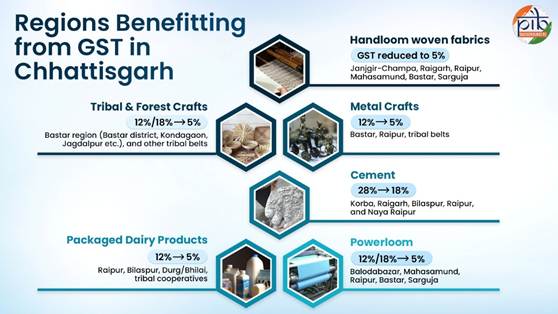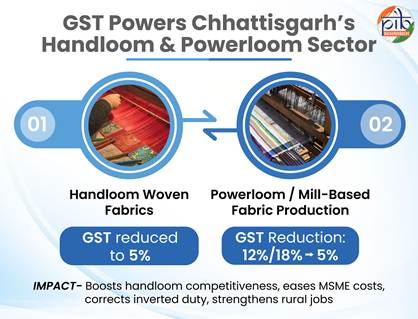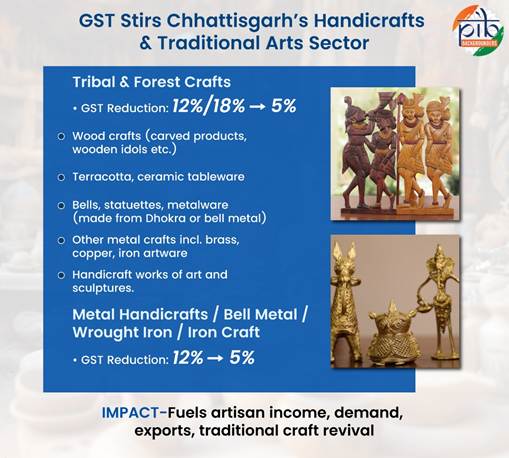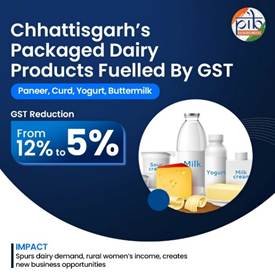PIB Headquarters
From Cement to Handloom: GST Sparks Inclusive Growth in Chhattisgarh
प्रविष्टि तिथि:
17 OCT 2025 1:55PM by PIB Delhi
Key Takeaways
- GST cuts ranging from 5-18% across handlooms, handicrafts, dairy, and cement industry in Chhattisgarh are boosting demand, supporting artisans, creating industrial and dairy jobs, and driving inclusive economic growth.
- Cement Industry: GST reduction to 18% lowers construction costs, drives housing demand, and sustains 20,000-30,000 jobs.
- Tribal & Forest Crafts: GST cut to 5% boosts demand by 10-15%, potentially creating 5,000 new jobs by 2026 and empowering women-led SHGs.
- Dairy Expansion: Lower GST on packaged dairy products stimulates consumption, supports 15,000-20,000 jobs, and assists NDDB to scale processing over 6x by 2028.
|
17 October, 2025
Introduction
Chhattisgarh, located in central India, was formed in 2000 after its separation from Madhya Pradesh. It is the country’s 9th largest state and home to over 25 million people. Rich in forests and natural resources, the state is known for its tribal heritage, cultural vibrancy, and industrial strength. Its art and craft traditions- from Bastar’s bell metal work and Raigarh’s bamboo art to the handwoven Kosa silk fabrics- reflect a living legacy of skill and sustainability.
Recent GST reforms offer a fresh momentum to Chhattisgarh’s economy. By lowering tax rates on essential goods and traditional sectors, these reforms reduce input costs, stimulate consumer demand, and make local products more competitive in national and global markets. The 5% GST rate on key sectors such as handlooms, handicrafts, and dairy not only eases the burden on small producers but also encourages formalisation and rural entrepreneurship, aligning with the state’s developmental priorities and inclusive growth vision.

Cement Industry
In Chhattisgarh, the cement and building materials industry has a strong presence across Korba, Raigarh, Bilaspur, Raipur, and Naya Raipur- regions experiencing rapid development and urbanization. This industry plays a vital role in the state’s economy, contributing through tax revenues and supporting ancillary industries. It also ranks among the largest employers in Chhattisgarh-
- Employment includes both permanent staff in organized plants (engineers, technicians, supervisors) and large numbers of contractual or unskilled workers engaged in mining, loading, kiln operation, packing, and transportation.
- Most workers come from rural or semi-urban backgrounds with limited formal education, and a significant portion are migrant labourers from Odisha, Jharkhand, and Uttar Pradesh.

- Average wages are modest- permanent workers earn ₹18,000-₹35,000 monthly, while contract workers typically earn ₹8,000-₹15,000.
- Women’s participation remains relatively low, mostly limited to packaging, loading, and allied services.
- The organized cement sector provides ~20,000-30,000 direct and indirect jobs.
- This includes ~10,000-15,000 direct employees across major plants, with indirect employment- such as contract labourers, transporters, and miners adding another 10,000-15,000 jobs.
- The cement sector's growth has been driven by infrastructure projects, with employment rising 5-10% annually owing to capacity expansions.
The reduction of GST on cement from 28% to 18% makes cement more affordable, lowering construction costs, stimulating housing demand, and generating additional employment opportunities in the infrastructure sector.
Handloom & Powerloom Sector
The handloom industry is one of Chhattisgarh’s most prominent cottage industries, deeply rooted in its cultural and economic fabric. Alongside, the state’s MSME and powerloom workforce plays a key role in supporting India’s larger textile ecosystem- one of the country’s biggest industrial contributors and a major source of national textile output.
Handloom Woven Fabrics
In Chhattisgarh, districts such as Janjgir-Champa, Raigarh, Raipur, Mahasamund, Bastar, and Sarguja form the crux of the state’s handloom network. Handloom woven fabrics include terry towelling and similar woven terry fabrics. The cotton handloom clusters of Raipur, Durg, Mahasamund, and Bastar, along with the tussar and kosa silk of Janjgir-Champa and Raigarh showcase the region’s artisanal excellence.
- The handloom sector provides a vital livelihood for nearly 1.5 lakh weavers, many of whom are women, engaged in decentralized rural production.
- Under the Prime Minister’s Employment Generation Programme (PMEGP), about 8,500 jobs have been created in handloom and allied rural industries over the last eight years (up to 2023).
- Further, in 2023, the Union Ministry of Textiles approved 51 handloom projects under the National Handloom Development Programme (NHDP) to strengthen skill training and group formation for economically weaker artisans.
The GST reduction to 5% further energizes this sector, making handwoven sarees and kosa/tussar silk fabrics more affordable and globally competitive. This gives a significant boost to Indian handloom products in export markets. The move not only stimulates consumer demand and boosts sales, but also empowers weavers, helping them compete effectively against cheap, machine-made textiles while sustaining Chhattisgarh’s weaving traditions- particularly benefitting the internationally recognized kosa/tussar silk.

Powerloom / Mill-Based Fabric Production
Powerloom weaving in Chhattisgarh is a semi-organized industrial activity, concentrated in clusters around Raigarh, Bilaspur, and Janjgir-Champa, with key hubs in Balodabazar, Mahasamund, Raipur, Bastar, and Sarguja.
- Production is largely dominated by small, family-run or contract-based units, often using outdated looms.
- Men typically operate the machines, while women handle winding, finishing, and packaging.
- The workforce is significant, comprising MSMEs and semi-skilled rural labourers, including many migrants from tribal and rural communities with limited formal education.
Recent GST reforms, trimming rates from 12%/18% to 5% offer a substantial boost to this sector. As the textile industry is India’s second-largest employer, favourable tax policies help sustain and create jobs, reduce input costs, improve margins, and enhance the global competitiveness of Indian textiles, boosting exports. Notably, the reforms are a relief for MSMEs as they ease the input tax burden, correct inverted duties, support working capital, and encourage formalization.
Handicrafts & Traditional Arts Sector
Beyond its tribal heritage, Chhattisgarh is famous for its diverse art and craft traditions. The state is home to various forms of metal, clay, and wood art, each reflecting deep-rooted cultural expression and craftsmanship. From the Dhokra metal casting and Bastar’s wooden carvings to its bell metal artifacts, Chhattisgarh’s artisans display skill and creativity. The state's jewellery, textiles, and terracotta crafts blend traditional aesthetics with contemporary appeal.
Tribal & Forest Crafts
The Bastar region- including Bastar, Kondagaon, and Jagdalpur, along with other tribal belts of Chhattisgarh, is renowned for its tribal and forest crafts. The state’s artisans create a wide variety of products such as wooden artifacts, Dhokra metalwork, wrought iron, bamboo, terracotta, and bell metal crafts, reflecting the cultural heritage and natural wealth of the region.
- ~50,000–60,000 artisans are engaged in handicrafts across Chhattisgarh, with tribal and forest-based crafts accounting for nearly 70–80% (35,000-48,000 artisans).
- The workforce includes full-time, part-time, and seasonal workers, mainly from Scheduled Tribes (STs) such as Gond, Halba, Bhatra, and Maria in the Bastar region.
- The sector provides self-employment and supplementary income to rural and tribal households, playing a vital role in poverty reduction in forested areas.
- These crafts generate ~₹500–800 crore annually (2024), with exports to the US and Europe supporting about 20-30% of jobs.
- From 2022 to 2024, artisan registrations under the Pahchan Card Scheme rose by 5–10%, reaching about 40,000- driven by growing e-commerce and export channels (through Shabari Emporia, for instance). However, climate-related pressures on forests continue to limit expansion.
- Under the National Handicrafts Development Programme (NHDP) and Comprehensive Handicrafts Cluster Development Scheme (CHCDS), the Ministry of Textiles has created 5,000-7,000 new jobs through skill training and cluster infrastructure (notably 2023-24 projects in Bastar for Dhokra and wood crafts).
- The PM Vishwakarma Scheme (launched in 2023) has registered over 10,000 artisans in Chhattisgarh, offering tools, credit, and market linkages, with a focus on tribal crafts. Notably, as of December 2023, ~1,000-2,000 have benefited directly in forest craft sectors.
The GST rate cut (from 12%/18% to 5%) increases demand by 10-15% and potentially adds 5,000 new jobs by 2026. Additionally, the reform enhances margins, boosts sales, and strengthens artisan livelihoods, particularly for those organized into Self-Help Groups (SHGs). The lower tax on raw materials such as tendu leaves further supports the income stability of tribal communities engaged in these traditional crafts.

Traditional Arts Sector- Metal Handicrafts / Bell Metal / Wrought Iron / Iron Craft
Metal handicrafts & bell metal / wrought iron / iron craft are practiced widely across Bastar, Raipur, and other tribal regions of Chhattisgarh, forming an integral part of the state’s artisanal economy. The Bastar Iron Craft (Dhokra art) holds a Geographical Indication (GI) tag, highlighting its cultural significance and traditional production techniques. This sector sustains thousands of livelihoods, particularly within the Bastar–Kondagaon clusters, and is actively promoted under the One District One Product (ODOP) initiative.
- An estimated 15,000-30,000 artisans in Chhattisgarh are engaged in various forms of metal craft, including bell metal, wrought iron, and traditional ironwork.
- The Kondagaon ODOP page records over 150 local artisans specializing in bell metal craftsmanship.
- Research on the Agaria tribe- traditional iron-smiths with a population of about 67,000- shows a substantial portion still involved in iron craft.
- Academic/ field studies across Bastar and Kondagaon confirm thousands of households depending on metal handicrafts for their income.
The GST reduction to from 12% to 5% provides a major boost to this sector by lowering production costs, improving sales, and supporting exports. The reform offers financial relief to tribal artisans, helping make their craft economically viable again while preserving traditional skills that were under strain from higher tax slabs.
Packaged Dairy Products
In Chhattisgarh, particularly in Raipur, Bilaspur, Durg/Bhilai, and tribal cooperative regions, dairy farming is a crucial livelihood, especially for women in rural and tribal communities. The state has over 1,068 dairy cooperative societies, with a significant number being women-led.
- A study of women’s groups in Raipur district shows that nearly 70% of members have marginal landholdings (<2.5 acres), and 60% report medium annual family incomes. Despite this, ~68% have not received formal training, highlighting a gap in capacity-building opportunities.
- The packaged dairy segment falls under food processing (NIC 105 for dairy products), one of the largest organized manufacturing employers in Chhattisgarh, accounting for ~12.91% of total registered manufacturing jobs (~15,000–20,000 positions statewide).
- Dairy processing specifically contributes significantly, with an estimated 1,500–3,000 direct jobs in organized units, including plant operators, quality testers, packers, and logistics staff, excluding informal or farm-level roles.
- The National Dairy Development Board (NDDB) partnership plans to expand processing capacity from ~79,000 kg/day to 500,000 kg/day by 2028, potentially generating 2,000–5,000 new jobs in processing, cold chains, and exports.

- Under state industrial policy and other schemes, ~500–1,000 jobs have been added in dairy clusters since 2023, with a focus on women (who account for 71% of the dairy workforce nationally, with similar trends in Chhattisgarh).
- Job vacancies indicate demand, with ~1,100 dairy-related openings listed on platforms like Naukri (2025), mostly in sales, quality control, and operations.
GST on packaged dairy products such as paneer, curd, yogurt, and buttermilk has been reduced from 12% to 5%. This reduction is expected to stimulate consumer demand, necessitating robust cold chain infrastructure for transport and storage. The policy not only creates new business opportunities and supports organized dairy production but also strengthens women-led rural enterprises, enhancing economic prospects for dairy farmers in these regions.
Conclusion
The recent GST reforms in Chhattisgarh- reducing rates across handlooms, handicrafts, metal and forest-based arts, packaged dairy, and cement- lowers production costs, boosts consumer demand, and enhances competitiveness. These measures empower women-led rural enterprises, sustains thousands of artisans, and supports organized industrial employment, while stimulating exports and formalization. By strengthening livelihoods, preserving traditional skills, and fostering new business opportunities, GST reforms are driving inclusive growth and positioning Chhattisgarh for sustainable socio-economic development.
References
cgstate.gov.in
https://cgstate.gov.in/en
incredibleindia.gov.in
https://www.incredibleindia.gov.in/en/chhattisgarh
cgapexhandloom.org.in
https://www.cgapexhandloom.org.in/portal/about-us
IBEF
https://ibef.org/exports/powerloom-industry-in-india
tourism.cgstate.gov.in
https://tourism.cgstate.gov.in/themes/Ethnic-Tribal
repository.tribal.gov.in
https://repository.tribal.gov.in/handle/123456789/74989?viewItem=browse
Click here for pdf file.
****
SK/M
(रिलीज़ आईडी: 2180263)
आगंतुक पटल : 546